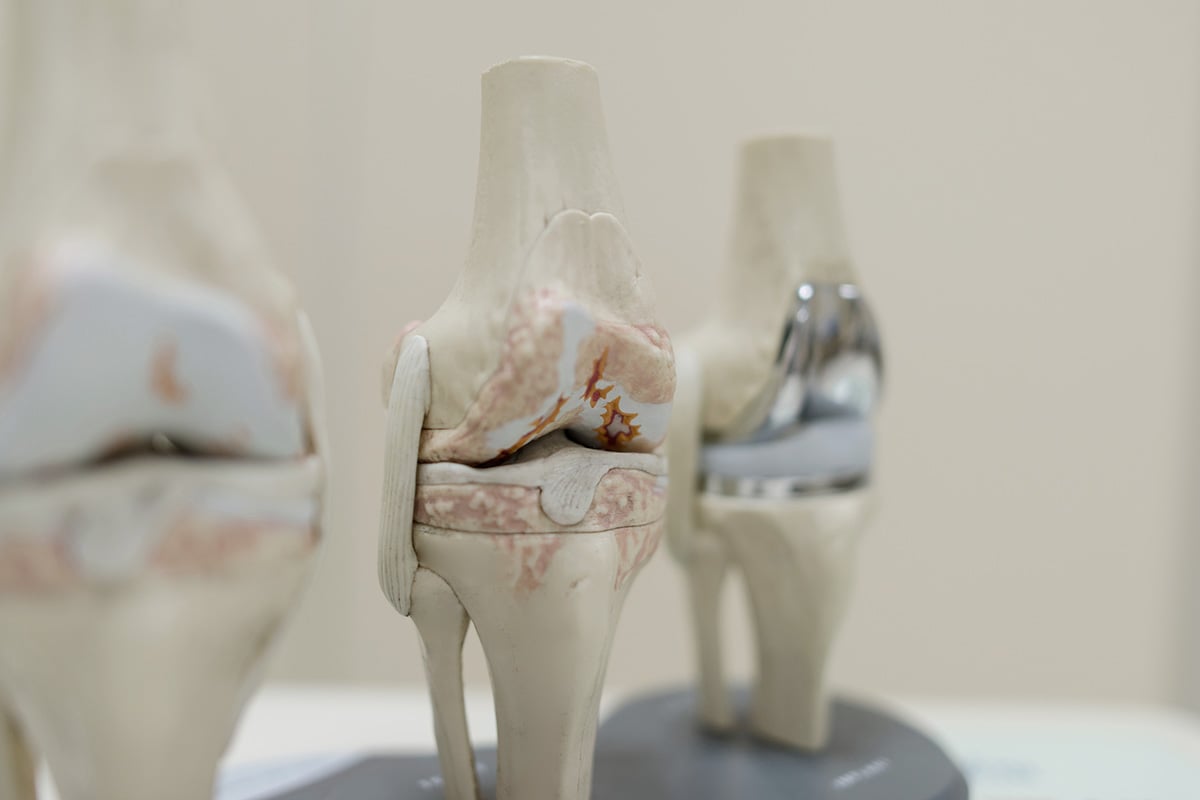Have you ever experienced these symptoms: knee ache, swollen knee, knee inflammation, crackling sound when walking, cannot extend your leg straight, including difficulties walking up and down the stairs? If so, these are warning signs for knee arthritis. Some risk factors are being middle-age or older, female, overweight, repeated trauma to the knees, previous knee injury, and genetics factors. If the knee surface suffered ample damage from inflammation or injuries, patients may feel pain when walking or using the stairs. If the damage is more severe, patients may feel aches and pains when they are sitting or sleeping.
Treatment begins simply by changing the way the patient uses their knees, taking anti-inflammatory medicines, or using a cane. If these pre-emptive measures are ineffective and the patient’s quality of life deteriorates, total knee replacement surgery may be an option. The damaged knee surface will be replaced with metal or plastic cap to gain usage of the joint. Current developments in surgical procedures and replacement materials allow of highly effective surgery. The patients can recover quickly and return to their normal routines.
Getting Acquainted with the Knees
The knee is the largest joint in the body and consists of three bones:
- The femur which is the upper leg bone,
- The tibia or the lower leg bone, and
- The patella or the kneecap.
They are joined together by ligaments and muscles that allow movement. Each piece of bone is capped with articular cartilage, which is the white, smooth tissue that acts as cushion for their interaction. The smooth cartilage allows for better movement, while synovial membrane, a thin smooth lining tissue, produces lubricant for the joint.

What Can Cause Knee Pain?
The most common causes of knee pain are arthritis or chronic knee inflammation, such as rheumatoid arthritis, and knee injury.
- Osteoarthritis usually occurs in patients who are 50 years old or older. It is caused by wear and tear of the cartilage, leading to the hard, rugged bones rubbing against each other. Patients will hear crackling sound during movement, which may be accompanied by pain and stiffness.
- Inflammatory arthritis, such as rheumatoid arthritis, causes the thickening of the synovium and more synovial fluid is produced in the joint, leading to swelling. If the inflammation is chronic, it can destroy the joints.
- Knee trauma or injury can destroy the cartilage from excessive force or cause fracture in the bone and cartilage.
Orthopedic Evaluations
- Complete history, including knee pain and movement assessments
- Physical examination, knee performance, surrounding muscle and ligament strengths
- Blood work to determine whether there is underlining inflammatory conditions, such as gout or rheumatoid
- Radiologic examination, such as X-ray, to assess the physical state of the knee
- In some cases, other radiologic exams, such as MRI, may be necessary to determine the state of surrounding tissues and ligaments.
Knee Treatment Options
Treatment begins simply by changing the patient’s physical activities to reduce tension and force on the knees by refraining from squatting, kneeling, using the stairs, jogging, and heavy lifting. Taking anti-inflammatory medication can also be helpful as well as knee muscle exercise to increase stability. If these options fail to improve the condition, direction injection with drugs, such as steroids or artificial synovial fluids, can be performed, to alleviate the pain and movement. Lastly, knee replacement surgery can be performed to get rid of the pain. Movement can improve and patients can begin walking after surgery with the aid of a walker.
Total Knee Replacement Surgery
Patients who receive total knee replacement surgery will feel less pain and can regain their quality of life. The patient will be admitted to morning of or the night before surgery. The anesthesiologist will assess and recommend the method of pain management suitable for individual patient. Methods include a systemic sedation or a spinal block. Total knee replacement surgery lasts approximately 1 – 2 hours. The damaged surface is surgically removed and prosthetic joint made of either metal or a composite is inserted to absorb the impact. After surgery, the patient will be observed in the recovery room for another 1 – 2 hours. Once the patient has gained consciousness, they will be moved to inpatient care ward. Most will stay in the hospital for 4 – 5 days. A physical therapist will begin rehabilitation immediately after surgery and subsequently help the patient to self-ambulate until they can be discharged and return to normal activities.
Why Choose the Hip and Knee Center, Bangkok International Hospital?
The Hip and Knee Center at Bangkok International Hospital is one of the pioneers of total knee replacement surgery using digital template program to plan the surgical position together with pain intervention technique, such as adductor canal block, and ultrasound waves (alternative supplement for pain management). Such combination minimizes pain and injury to surrounding tissues. Complications after surgery is also reduced, resulting in quicker recovery and patients can walk again within 24 hours as well as return to their daily routine quicker.
- A team of medical specialists highly experienced in knee replacement surgery along with multidisciplinary team of medical professionals, including anesthesiologist, physical therapist, and internist work together to ensure comprehensive care for the patient.
- World-class standard certification for total knee replacement program by JCI in the USA.
- High technology (digital template / pre-operative planning program) is used to plan precise procedure to decrease injury to the surrounding tissues as well as indicate the size and position of the prosthetic to lengthen its lifetime of use.
- Pain management techniques, such as adductor canal block and radiofrequency ablation (radiofrequency ablation is an additional option), are used to minimize pain.
- Standard and premium prosthetic joints last at least 15 – 20 years.
- Low risk of complications, such as nerve damages, infections, or blood clots.
- Enhanced Recovery After Surgery (ERAS) Program help quick recover with a team of experienced physical therapists. Patients can walk within 24 hours after surgery and return to their normal routines.